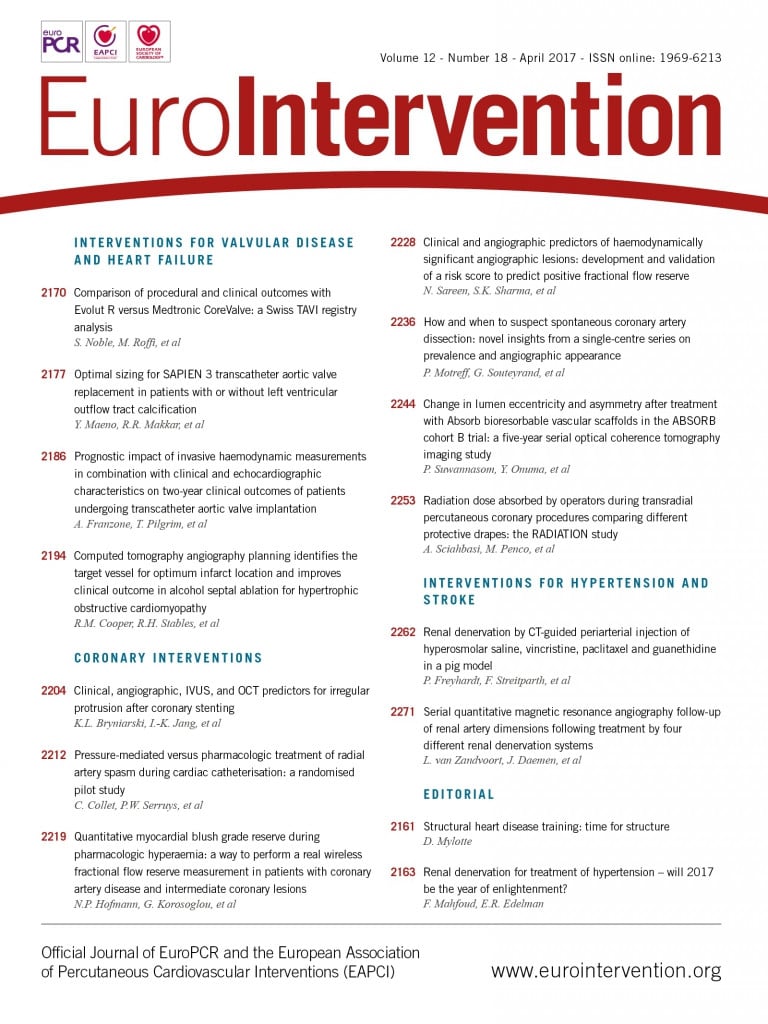
Despite its demonstrated value in guiding coronary revascularisation1, the rate of adoption of fractional flow reserve (FFR) in real-world clinical practice remains low. For this reason, we read with interest the article from Leone et al on the value of contrast-based FFR (cFFR)2. The MEMENTO study expands upon the observations made in previous studies on the potential value of cFFR3,4. However, we would like to share with the authors our concerns about the interpretation of studies that compare physiological indices using the approach taken in MEMENTO and their views on the value of non-hyperaemic indices such as Pd/Pa and iFR.
As in previous studies3,4, the authors assessed the diagnostic efficiency of cFFR and Pd/Pa using FFR as a standard of reference. However, there are two matters of concern when this approach is adopted. The first refers to the fallibility of FFR. The validation of FFR against non-invasive ischaemia testing (stress echo, SPECT) was performed in a small and very selected study population5. In studies performed in clinical populations, such as the MEMENTO trial, the diagnostic efficiency of FFR has been reported to be substantially lower6,7. Thus, it is important to bear in mind that any comparison of new functional tests against FFR will be fraught by the limits of FFR as a diagnostic tool. The ADVISE II trial8 provides an opportunity for discussing the implications of interpreting the results of indices compared against FFR. In that study, the areas under the curve (AUC) of Pd/Pa and the instantaneous wave free ratio (iFR), compared with FFR, were virtually identical. However, this cannot directly answer the question as to whether iFR is as good as FFR in identifying haemodynamically severe stenoses, nor does it imply that Pd/Pa has a similar diagnostic efficiency to iFR for that purpose. Two different indices under evaluation, one of them superior and the other one inferior to FFR in identifying significant stenoses, might have identical AUC when FFR is used as a reference.
A second concern refers to the mechanistic similarity with FFR of some of the indices included in this type of validation. The three indices compared in the MEMENTO study share a common mechanistic basis: they all are trans-stenotic pressure ratios based on mean Pa and Pd pressures (i.e., averaged pressure values over the whole cardiac cycle). It should not come as a surprise that induction of hyperaemia with contrast medium increases the diagnostic efficiency of contrast FFR when compared with Pd/Pa, as it introduces a second mechanistic principle found in FFR, namely increased coronary flow during hyperaemia. Yet, a completely different scenario takes place in comparing iFR and FFR. iFR is mechanistically different from FFR, Pd/Pa and cFFR; it is a trans-stenotic pressure ratio obtained within a selective part of the cardiac cycle. If FFR is used as a reference, the diagnostic efficiency of iFR should always be relatively low because, to use an analogy, it results from comparing apples with oranges.
A better solution for assessing the diagnostic performance of cFFR would be to perform a head-to-head comparison of FFR, cFFR, Pd/Pa and iFR against non-invasive tests detecting myocardial ischaemia7. As a matter of fact, studies of this kind have shown that, when using myocardial perfusion imaging as a reference, the AUC for FFR, Pd/Pa and iFR are not significantly different7. Ultimately, non-inferiority randomised clinical studies to assess the clinical impact of cFFR, such as those initiated for non-hyperaemic indices9, may be required. We would be very curious to see how cFFR performs in such a head-to-head comparison, not only with its next of kin FFR and Pd/Pa, but also with iFR.
Conflict of interest statement
The authors have no conflicts of interest to declare.

